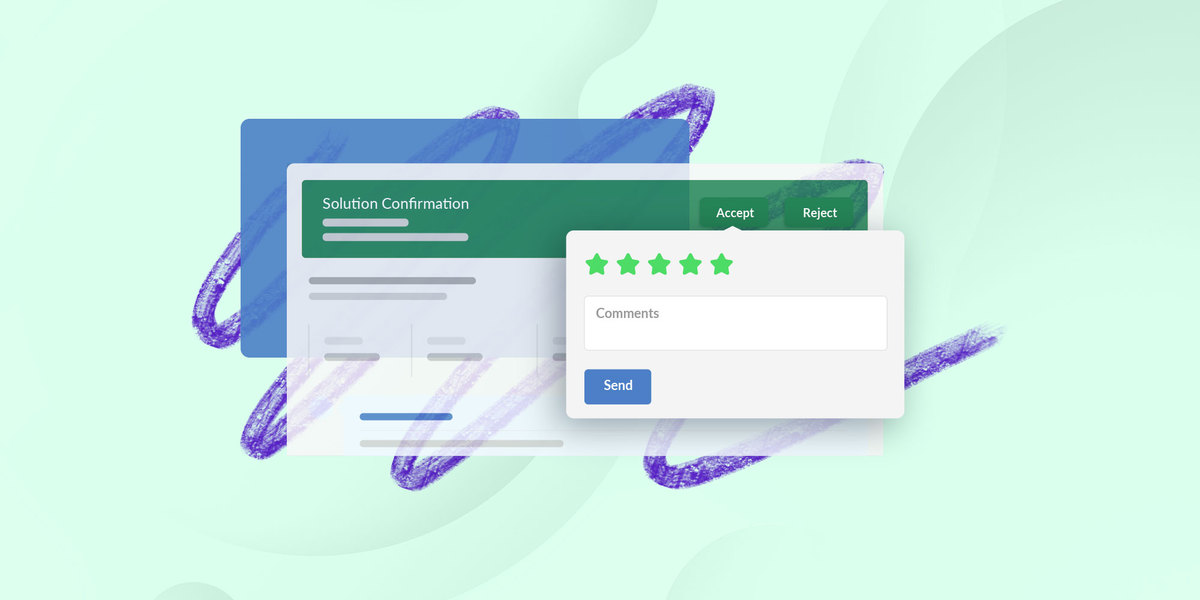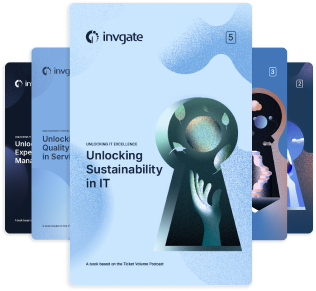When we talk about IT support, a lot comes to mind—helping users resolve issues, maintaining systems, and ensuring that technology keeps everything running smoothly. But under this broad umbrella lies a key concept that often gets overlooked or misunderstood: IT support strategy.
At first glance, it might not sound like a game-changer. After all, isn’t IT support just about being reactive to problems? Well, not quite. A strong IT support strategy can make or break an organization’s ability to thrive in today’s tech-driven world. It’s not just about solving tickets; it’s about crafting a plan that ensures your IT support is efficient, proactive, and aligned with your business goals.
In this blog post, we’re diving into exactly what an IT support strategy is, why it’s so important, and how you can develop one that actually works. Plus, we’ll share a story from our experience at InvGate where a well-thought-out IT support strategy didn’t just improve operations—it transformed them.
So, whether you’re convinced of its value or skeptical about whether you even need one, stick around. By the end of this article, you’ll have all the insights you need to reimagine how your IT support operates—and why that’s a big deal for your organization.

What is an IT support strategy?
Let’s start with the basics. An IT support strategy is a structured plan designed to ensure that all IT support initiatives are aligned with your organization’s overarching goals. It’s more than just troubleshooting and resolving issues—it’s about creating a cohesive approach that makes IT support efficient, proactive, and a driver of business success.
Now, here’s where it gets interesting—there’s some debate about whether IT support strategy is even a "real thing". If you’ve ever wandered into the IT corners of Reddit (like this lively MSP debate), you’ve likely seen arguments over whether IT strategy, and by extension IT support strategy, is just jargon or something tangible.
Let’s settle that debate: It absolutely exists, and it’s worth taking seriously. While it may not look the same for every organization, an effective IT support strategy has clear value. It sets the tone for how IT teams operate, impacts user satisfaction, and ultimately plays a pivotal role in achieving business objectives.
What makes up an IT support strategy?
Now that we’ve defined what an IT support strategy is, let’s explore the elements that make it effective. While IT support strategies can vary depending on the size and goals of your organization, their core purpose remains the same: to ensure IT support is efficient, proactive, and aligned with business objectives.
#1: Alignment with business objectives
At the heart of any IT support strategy is the need to align IT support initiatives with the organization’s overarching goals. By defining how IT contributes to your business objectives—whether it’s improving customer satisfaction or optimizing internal processes—you ensure your strategy is relevant and impactful.
#2: Assessment of current IT support operations
A clear understanding of where you stand is critical to mapping out where you need to go. This involves evaluating your current IT infrastructure, workflows, team capabilities, and user feedback. Identifying strengths and areas for improvement sets the foundation for a targeted approach.
#3: Proactive identification of technology needs and trends
IT support is not just about keeping systems running—it’s about staying ahead of the curve. Your strategy should include identifying tools and processes that can enhance support delivery while keeping pace with industry trends.

#4: Resource allocation and budgeting
Effective IT support doesn’t happen without careful planning of resources. Whether it’s allocating funds for new tools, staffing, or training, this component ensures that you’re prioritizing the areas that will have the greatest impact.
#5: Risk Management and security planning
Security is a cornerstone of IT support. Your strategy should outline measures to assess risks, safeguard sensitive data, and remain compliant with regulations. This isn’t just about damage control; it’s about ensuring trust and resilience in your support framework.

#6: Performance measurement and continuous improvement
No strategy is complete without a way to measure success. By setting clear KPIs and regularly reviewing progress, you can adapt and refine your strategy over time. Metrics like ticket resolution times, user or user satisfaction scores, and cost efficiency are key indicators of how well your IT support is functioning.
How to develop an IT support strategy process
Creating and maintaining an IT support strategy involves several key phases. It’s not a one-and-done exercise—it’s a continuous process that evolves alongside your organization’s needs and goals. The process can be broken down into four main stages:
- Planning: Defining objectives, understanding your organization’s needs, and creating a roadmap.
- Execution and implementation: Putting the strategy into action by implementing tools, processes, and workflows.
- Monitoring and optimization: Tracking performance and making necessary adjustments to improve outcomes.
- Continuous improvement and scaling: Evolving your strategy to keep up with organizational growth and technological advancements.
And like any good initiative, it all starts with solid planning.
Key activities in IT support strategy planning
Planning is the foundation of any successful IT support strategy. During this phase, you’re setting the stage for everything that comes next by defining your objectives, understanding your organization’s needs, and laying out a roadmap. Here are the key activities involved:
- Understand your business goals.
- Assess current IT support performance.
- Identify user needs and expectations.
- Define clear objectives.
- Create a high-level roadmap.
#1: Understand your business goals
The first step is to get crystal clear on your organization’s objectives. What are the business goals, and how can IT support contribute to achieving them? For example, is your company focused on scaling operations, improving customer satisfaction, or increasing employee productivity? Your strategy should directly support these priorities.
#2: Assess current IT support performance
Conduct a thorough evaluation of your existing IT support setup. This includes analyzing ticket resolution times, user satisfaction scores, team performance, and current workflows. The aim is to identify strengths to build on and areas that need improvement.
#3: Identify user needs and expectations
Understanding what your users need is crucial to tailoring your IT support strategy. Collect feedback from employees or customers, look at recurring support issues, and evaluate how well your current system meets their expectations.

#4: Define clear objectives
Based on your findings, outline the specific objectives of your IT support strategy. These could range from reducing response times to implementing a self-service portal or improving first-call resolution rates. Ensure these objectives are measurable so that you can track progress.
#5: Create a high-level roadmap
Finally, map out the major steps your organization will need to take to reach its goals. This roadmap doesn’t need to be overly detailed at this stage but should give a clear sense of direction for the strategy.
Execution and implementation
After planning, the next phase is execution and implementation. This step involves bringing your strategy to life by implementing tools, processes, and workflows that align with your goals.
- Select the right tools and technologies.
- Define workflows and processes.
- Onboard and train your team.
#1: Select the right tools and technologies
Based on the roadmap established during the planning phase, select the tools and technologies that will help you achieve your IT support objectives. The right IT support software plays a critical role in the success of your strategy. This could include solutions like IT Service Management (ITSM) platforms.
And now, let me take a minute for some shameless promotion. A great example of ITSM software is InvGate Service Management, which offers features like an automated ticketing system, process automation, and robust analytics to enhance IT support operations. When selecting software, ensure it integrates seamlessly with your existing infrastructure, addresses specific pain points, and supports your strategy’s broader goals. For a smoother software selection process, it’s a good idea to use a ITSM Request for Proposal (RFP) template—and you can download one for free from our blog!

#2: Define workflows and processes
Establishing clear workflows is essential for efficient IT support operations, regardless of the tool you use. This is really easy with InvGate Service Management's no-code workflow builder. It enables you to design, modify, and automate processes with ease, even without technical expertise. This intuitive tool allows you to create workflows that streamline ticket resolution, set up escalation paths, and manage knowledge base updates, ensuring that each support task is handled promptly and effectively.
#3: Onboard and train your team
Equip your team with the skills and knowledge they need to succeed. Provide training on new tools, outline the updated workflows, and ensure they understand how their roles align with the broader IT support strategy. A well-trained team is crucial to seamless implementation.
Unlocking Career Progression
Discover the strategies to lifelong learning and evolvement in IT
Download for free
Monitoring and optimization
With your IT support strategy in place, it’s essential to monitor its performance and optimize it over time. This phase ensures that your strategy remains effective and evolves to meet changing needs.
- Track key performance indicators (KPIs).
- Collect ongoing feedback from users.
- Adjust and refine processes.
#1: Track key performance indicators (KPIs)
Define and track metrics to evaluate your strategy’s success. Common KPIs include ticket resolution times, user satisfaction scores, and system uptime. Regularly reviewing these metrics provides insights into what’s working and what needs improvement.
#2: Collect ongoing feedback from users
Your users are the ultimate beneficiaries of IT support, so their input is invaluable. Use surveys, feedback forms, or interviews to gather insights into their experiences and identify areas for improvement.
#3: Adjust and refine processes
Use the data from your KPIs and user feedback to make adjustments to your workflows, tools, or team structure. Continuous refinement ensures your strategy stays relevant and effective.
Continuous improvement and scaling
The final step in developing an IT support strategy is ensuring it grows with your organization and adapts to future challenges.
- Scale processes and resources as needed.
- Stay proactive about technology trends.
- Reassess regularly to align with organizational goals.
#1: Scale processes and resources as needed
As your organization grows, your IT support strategy should scale accordingly. This could involve expanding your team, upgrading tools, or automating repetitive tasks to handle increased demand.
#2: Stay proactive about technology trends
The IT landscape evolves rapidly, so staying ahead of trends is crucial. Continuously evaluate emerging tools and practices to ensure your IT support remains competitive and effective.
#3: Reassess regularly to align with organizational goals
Periodic reassessments of your IT support strategy ensure it continues to align with your organization’s objectives. Review your goals, KPIs, and user needs regularly to keep your strategy relevant and impactful.
A real-world IT support strategy example: Austral University
Austral University’s journey to transforming its IT support operations offers a compelling example of how a well-crafted IT support strategy can create significant organizational impact. Faced with the challenge of decentralization and inefficiency, the university needed a solution that could streamline support, improve service quality, and meet the growing expectations of its users.
By adopting InvGate Service Management as the cornerstone of its IT support strategy, Austral University centralized its operations, consolidating support into a single platform. This strategic move allowed the institution to break down silos, automate processes, and gain greater visibility into support activities. As a result, the IT team was able to significantly improve resolution times and deliver a more efficient and transparent support experience to both staff and students.
What truly sets Austral University’s approach apart is its user-centric focus. The university’s IT support strategy wasn’t just about implementing technology; it was about aligning processes with user needs. By making customer satisfaction a priority and addressing specific pain points through thoughtful planning and execution, they successfully elevated the role of IT support as a critical enabler of their academic mission.
This case highlights the importance of starting with a clear strategy that aligns IT support with broader organizational goals. From planning and implementation to ongoing optimization, Austral University’s experience underscores how a strategic approach can drive meaningful results for any organization.
Why is it important to pursue strategic IT support?
Strategic IT support is more than just a way to keep systems running—it’s a critical enabler of business success. By taking a proactive and well-planned approach, organizations can unlock a range of benefits that directly impact their efficiency, user satisfaction, and bottom line. Let’s dive into the key reasons why pursuing strategic IT support is so important:
#1: Improved operational efficiency
A strategic IT support strategy streamlines processes and optimizes resource allocation. By using tools like IT support software and implementing well-defined workflows, your organization can reduce downtime, resolve issues faster, and eliminate bottlenecks. This means your IT team spends less time firefighting and more time driving innovation.
#2: Enhanced user satisfaction
When IT support is aligned with user needs, it leads to happier employees and customers. Strategic IT support ensures faster response times, more accurate resolutions, and a better overall experience. Features like self-service portals and knowledge bases empower users to solve common problems on their own, adding another layer of convenience.
#3: Alignment with business objectives
Strategic IT support ties IT operations directly to organizational goals. Whether it’s improving productivity, scaling operations, or enhancing customer service, a clear strategy ensures IT support contributes meaningfully to the bottom line. This alignment transforms IT from a cost center into a value driver.
#4: Proactive problem-solving
A strategic approach shifts IT support from reactive to proactive. By leveraging analytics and monitoring tools, you can identify potential issues before they escalate, minimizing disruptions. This not only saves time and resources but also prevents small problems from snowballing into major crises.
#5: Better decision-making with data-driven insights
Strategic IT support relies on data to guide decisions. With tools like InvGate Service Management, you can track key metrics such as resolution times and user satisfaction to continuously improve. Data-driven insights help you identify trends, optimize resources, and prioritize areas that need attention.
#6: Scalability for future growth
As organizations grow, so do their IT demands. A strategic IT support framework ensures your processes and tools can scale to meet increasing needs. Whether it’s automating repetitive tasks or expanding your IT team, scalability is built into the strategy to accommodate future challenges.

6 challenges of an IT support strategy
While an IT support strategy offers numerous benefits, developing and maintaining one isn’t without its hurdles. These challenges can arise from resource constraints, resistance to change, or the complexity of aligning IT with business goals. By understanding these obstacles, organizations can proactively address them and ensure their strategy’s success. Let’s explore the key challenges:
#1: Limited resources
Implementing a strategic IT support framework often requires investment in tools, training, and personnel. For smaller organizations or those with tight budgets, allocating these resources can be a significant challenge. Balancing immediate operational needs with long-term strategic goals requires careful prioritization and planning.
#2: Resistance to change
Change management is a common hurdle when rolling out an IT support strategy. Teams and users may resist new workflows, tools, or processes, particularly if they are accustomed to legacy systems. Overcoming this resistance requires clear communication about the benefits of the strategy, thorough training, and strong leadership support.
#3: Misalignment with business objectives
One of the most critical challenges is ensuring the IT support strategy aligns with broader business goals. Without a clear understanding of these objectives, the strategy may become disconnected, focusing on technical aspects rather than delivering value to the organization. Regular collaboration between IT and other departments is essential to maintain alignment.
#4: Maintaining scalability
As organizations grow, their IT support needs become more complex. Scaling a strategy to handle increased demand, larger teams, or more sophisticated technologies can be difficult without proper foresight. Anticipating growth and building flexibility into the strategy is key to overcoming this challenge.
#5: Lack of data visibility
Strategic IT support relies heavily on data to guide decisions, but many organizations struggle with insufficient data visibility. Incomplete or siloed data can hinder performance tracking, problem identification, and overall optimization. Investing in tools that centralize and analyze data is crucial to addressing this issue.
#6: Keeping up with technological advancements
The rapid pace of technological change can make it difficult for organizations to keep their IT support strategy up to date. Falling behind on tools or processes can result in inefficiencies and missed opportunities. Continuous evaluation of emerging trends and regular strategy updates are necessary to remain competitive.
Future trends in strategic IT support
As IT support evolves, organizations are embracing new strategies and technologies to stay ahead. Some of these trends were discussed in episode 08 of the Ticket Volume – IT Podcast, where Megan Engels, VP of IT Support at Peoples Bank and an InvGate customer, shared her insights from over 20 years of experience. Megan highlighted the human side of IT, the importance of adaptability, and the growing role of training and data in shaping the future of IT support. Let’s explore these trends in detail:
#1: Personalized and human-centered IT support
The future of IT support goes beyond solving technical problems; it’s about understanding and addressing the unique needs of users.
“There’s just such a human element to everything we do in support. It’s like working in the ER without any blood.”
Megan Engels
IT Support Manager for Peoples Bank
Episode 08 - Ticket Volume
By focusing on communication, empathy, and tailored solutions, IT teams can enhance user satisfaction and build stronger relationships with their customers.
#2: Change Management and adaptability
The IT landscape is changing at a faster pace than ever, making adaptability a cornerstone of future IT support strategies. As Megan put it, “You can always do it better…where you are now, you might look back in five years and think, ‘Did I use a crayon there?’” Organizations that embed change adoption into their culture will be better equipped to navigate challenges and seize opportunities.

#3: Automation and artificial intelligence
One major trend reshaping IT support is the rise of IT support automation and AI-driven tools. From chatbots for handling routine inquiries to AI-powered analytics for identifying issues, these technologies enhance efficiency and reduce human workloads. Automation allows teams to focus on higher-value tasks, driving both productivity and innovation.
#4: The role of training and digital content
Megan’s emphasis on training aligns with a growing trend: the integration of learning programs and digital content into IT support strategies. By standardizing training materials and creating resources like self-service portals, organizations can ensure consistent user experiences while saving valuable time.
“Digital content not only saves time but creates a consistent user experience.”
Megan Engels
IT Support Manager for Peoples Bank
Episode 08 - Ticket Volume
#5: Data-driven insights and proactive problem solving
Data is becoming the backbone of strategic IT support. Organizations are increasingly using analytics tools to identify trends, optimize workflows, and predict potential issues before they escalate. This proactive approach not only minimizes disruptions but also enables smarter decision-making at every level of IT operations.
#6: Sustainability in IT support
An emerging focus is on making IT support more sustainable by minimizing environmental impact. This includes extending the lifecycle of hardware, implementing energy-efficient data centers, and adopting tools that reduce waste. Sustainability is not just a corporate responsibility but also an area where IT can drive cost savings.
Unlocking Sustainability in IT
Discover the importance of embracing sustainability in IT.
Download for free
#7: Scalable and multi-tenant solutions
As organizations grow, they require IT support strategies that can scale seamlessly. Megan highlighted this in her experience with InvGate’s multi-tenant capabilities, which allowed Peoples Bank to maintain separate workflows for HR, IT, and retail while passing tickets effortlessly between departments. This scalability ensures IT support systems remain effective, even as complexity increases.
Final thoughts
An IT support strategy isn’t just a nice-to-have; it’s an essential tool for any organization looking to thrive in today’s fast-paced, tech-driven world. From aligning IT initiatives with business objectives to proactively solving problems and leveraging the latest tools like InvGate Service Management, a strategic approach transforms IT support into a true enabler of success.
We’ve explored what an IT support strategy is, how to build one, and why it’s worth the investment. By taking the time to plan, implement, monitor, and continuously improve, your organization can unlock the full potential of IT support—enhancing efficiency, user satisfaction, and scalability along the way.
As the landscape evolves, so too must your IT support approach. Whether it’s embracing AI and automation, prioritizing sustainability, or fostering adaptability, staying ahead of the curve will ensure your IT support continues to deliver value. Start crafting your strategy today, and set the foundation for a future-ready, resilient IT support framework.















